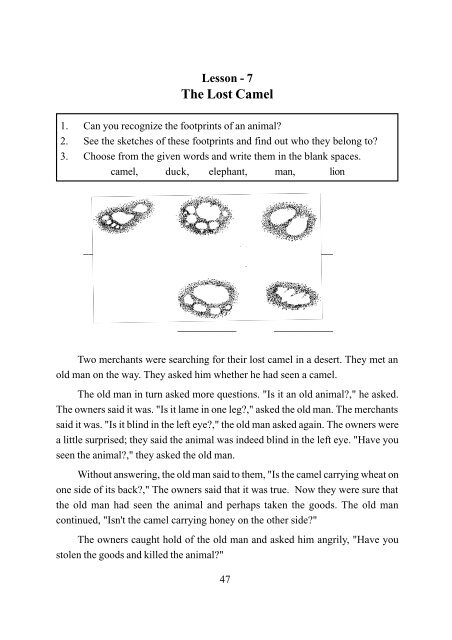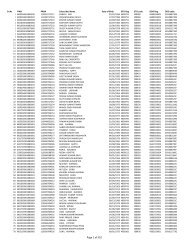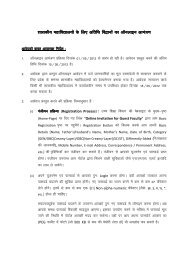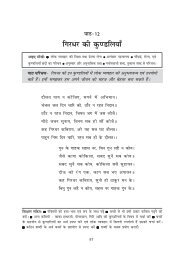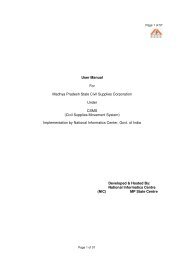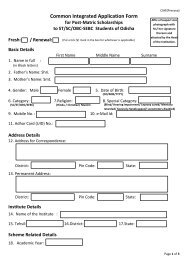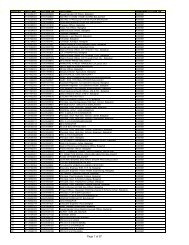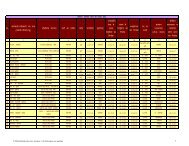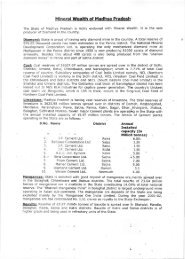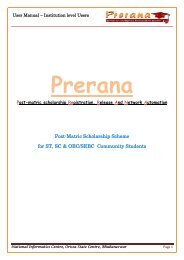Lesson â 7 The Lost Camel
Lesson â 7 The Lost Camel
Lesson â 7 The Lost Camel
You also want an ePaper? Increase the reach of your titles
YUMPU automatically turns print PDFs into web optimized ePapers that Google loves.
<strong>Lesson</strong> - 7<br />
<strong>The</strong> <strong>Lost</strong> <strong>Camel</strong><br />
1. Can you recognize the footprints of an animal<br />
2. See the sketches of these footprints and find out who they belong to<br />
3. Choose from the given words and write them in the blank spaces.<br />
camel, duck, elephant, man, lion<br />
___________ ___________ ___________<br />
___________ ___________<br />
Two merchants were searching for their lost camel in a desert. <strong>The</strong>y met an<br />
old man on the way. <strong>The</strong>y asked him whether he had seen a camel.<br />
<strong>The</strong> old man in turn asked more questions. "Is it an old animal," he asked.<br />
<strong>The</strong> owners said it was. "Is it lame in one leg," asked the old man. <strong>The</strong> merchants<br />
said it was. "Is it blind in the left eye," the old man asked again. <strong>The</strong> owners were<br />
a little surprised; they said the animal was indeed blind in the left eye. "Have you<br />
seen the animal," they asked the old man.<br />
Without answering, the old man said to them, "Is the camel carrying wheat on<br />
one side of its back," <strong>The</strong> owners said that it was true. Now they were sure that<br />
the old man had seen the animal and perhaps taken the goods. <strong>The</strong> old man<br />
continued, "Isn't the camel carrying honey on the other side"<br />
<strong>The</strong> owners caught hold of the old man and asked him angrily, "Have you<br />
stolen the goods and killed the animal"<br />
47
" I have not even seen the animal," said the old man calmly.<br />
<strong>The</strong> merchants asked him, "Do you think we are fools to believe your story"<br />
And they dragged him to the Khalifa's court.<br />
<strong>The</strong> Khalifa listened to the merchants' *story. <strong>The</strong>n he turned to the old man<br />
and asked him whether he had seen the camel. <strong>The</strong> old man said he had never seen<br />
it in his life. "How do you know the camel is lame in one leg", the Khalifa asked.<br />
"I looked at the footprints on the sand," said the old man. "And one of them<br />
could hardly be seen."<br />
<strong>The</strong> Khalifa smiled and asked why the old man thought the camel was blind in<br />
one eye.<br />
"<strong>The</strong> animal had eaten the leaves of the bushes only on one side of the road,"<br />
said the old man.<br />
* Note the use of apostrophe ('). <strong>The</strong> apostrophe mark is placed after the (s') in case of<br />
a plural noun and before ('s) in case of a singular noun.<br />
48
"Why did you think the camel was carrying wheat and honey," asked the<br />
Khalifa.<br />
"I saw ants carrying fallen grains of wheat from one side of the road," said<br />
the old man.<br />
"And there were bees flying around on the other side, I suppose," said the<br />
Khalifa.<br />
"Yes, Your Honour,*" said the old man.<br />
<strong>The</strong> Khalifa then turned to the merchants and said, "This man has made use<br />
of his eyes to look at things. You have eyes too. Use them. You'll find your<br />
animal."<br />
And he sent them away.<br />
1. Read and Learn:<br />
the ship of the desert a lame excuse, foolproof<br />
to work hard to turn a blind eye to leave one's footprints<br />
merchant<br />
desert<br />
angrily<br />
calmly<br />
surprise<br />
perhaps<br />
dragged<br />
footprints<br />
2. Comprehension:<br />
A) Answer the following questions :<br />
1. Why were the two merchants surprised at the old man's questions<br />
2. Why did the merchants think that the old man had seen the camel <br />
3. Why did they take the old man to the Khalifa<br />
4. How did the old man know that the camel was blind<br />
5. Why were the bees flying only on one side of the road <br />
6. Why did the Khalifa not punish the old man<br />
* Your Honour: an address of respect to a judge.<br />
49
B) Complete the following sentences using the correct option:<br />
1. <strong>The</strong> two merchants were looking .....<br />
a) for their friend<br />
b) for their lost camel<br />
c) for their family members<br />
2. <strong>The</strong> old man's answers were in the form of .....<br />
a) silence<br />
b) statements<br />
c) questions<br />
3. <strong>The</strong> old man asked whether....<br />
a) the camel could not walk fast<br />
b) the camel carried a heavy load<br />
c) the camel was lame<br />
4. <strong>The</strong> merchants were angry because....<br />
a) they thought that the old man had stolen the goods and killed the camel.<br />
b) they thought that the old man was making fun of them.<br />
c) they thought that they would never get their camel back.<br />
5. <strong>The</strong> old man knew the camel was lame because ....<br />
a) one of its footprints could hardly be seen<br />
b) the ants carried fallen grains from one side of the road<br />
c) he had seen the camel before<br />
6. <strong>The</strong> Khalifa said that the old man knew so much about the camel because...<br />
a) he was an expert<br />
b) he had killed the camel<br />
c) he used his eyes to look at things carefully<br />
7. <strong>The</strong> merchants went to....<br />
50
a) the camel<br />
b) the khalifa<br />
c) the king<br />
8. <strong>The</strong> camel was....<br />
a) lame in one leg<br />
b) blind in one eye<br />
c) both lame in one leg and blind in one eye<br />
9. <strong>The</strong> Khalifa said to the merchants....<br />
a) use your ears<br />
b) use your eyes<br />
c) use your mouth<br />
10. <strong>The</strong> old man had....<br />
a) stolen the camel<br />
b) killed the camel<br />
c) never seen the camel<br />
3. Word Power:<br />
A) Match the words with their meanings:<br />
1. without excitement calmly<br />
2. a tiny insect merchant<br />
3. a person who buys and sells goods lame<br />
4. disabled in the leg or foot footprint<br />
5. the mark left by a foot or shoe bee<br />
B) Fill in the blank spaces in the sentences, using the given words or<br />
phrases:<br />
(carrying, understand, were searching, the ship of the desert, a lame excuse,<br />
foolproof, to work hard, to turn a blind eye, leave footprints, angry)<br />
51
1. Bhola was ______ for his ball.<br />
2. <strong>The</strong> truck was ______ bags of onions.<br />
3. <strong>The</strong> teacher was ________ because Suraj did not do his work.<br />
4. No one could ______ the story told by Ramesh.<br />
5. <strong>The</strong> police __________ when they saw the thief was running away.<br />
6. <strong>The</strong> camel is known as ________________.<br />
7. Ramesh had not done his homework so he made ____ of falling sick.<br />
8. Some products in the market claim to be a _____ remedy for illness.<br />
9. Shyama has __________ to secure good marks.<br />
10. If you ______ on the sand at a beach, the sea is sure to wash them away.<br />
4. Grammar in Use:<br />
A) Fill in the blank spaces with the correct form of the verbs:<br />
Two boys _______ (play) in the ground with a ball. A few boys _____<br />
(watch) them. All of them _____(enjoy) their free time. Suddenly it started<br />
_______ (rain). Now all of them _____ (run) back to their rooms. One of<br />
them ____ (pick) up the ball.<br />
B) Frame questions to get the following answers. Start with the 'wh' word<br />
given in front of each sentence.<br />
Example : Suman has her lunch at office. (where)<br />
Where does Suman have her lunch<br />
1. She has her lunch at 10 o' clock. (when)<br />
2. She has chappaties and vegetables for lunch. (what)<br />
3. She had dinner at her friend's home last night. (where)<br />
52
5. Let's Talk:<br />
You are talking to a friend on telephone who has returned from a journey<br />
during vacation. Ask five questions about his/her journey.<br />
Where did<br />
you go<br />
I went to<br />
Pachmarhi<br />
What's the weather<br />
like at Pachmarhi<br />
It's really<br />
fine.<br />
6. Let's Write:<br />
A) 1. Imagine that you are the camel in the story. Write the story using the<br />
following words :<br />
lake, tracks, footprints, went back, happy, leaves, lost, sand<br />
2. Give a title to your story.<br />
7. Let's Do It:<br />
A) Write the names of the animals / birds given below:<br />
the largest land<br />
animal long trunk<br />
eats leaves and fruits<br />
a wild animal<br />
black and white<br />
stripes<br />
eats leaves<br />
a flightless bird<br />
white and black<br />
eats fish<br />
a tall animal<br />
long neck<br />
eats leaves<br />
53
Write at least four sentences about each of the four pictures shown above.<br />
Use the clues given in the boxes.<br />
_______________________________________________________<br />
_______________________________________________________<br />
_______________________________________________________<br />
_______________________________________________________<br />
_______________________________________________________<br />
_______________________________________________________<br />
_______________________________________________________<br />
_______________________________________________________<br />
B) Read the following passage carefully and then answer the questions<br />
given below it.<br />
<strong>The</strong> camel is one of the oldest of the domestic animals. It has been used for<br />
thousands of years by the desert people of Africa and Asia to fulfil several of their<br />
needs.<br />
On the fertile edges of the desert, camels<br />
pull ploughs, turn wheels to irrigate fields and<br />
carry goods to the market. In the desert itself,<br />
they are still almost the only means of<br />
transport. <strong>The</strong>y supply food, milk and clothing<br />
in the form of wool and leather.<br />
This useful animal is well adapted to life<br />
in harsh, dry lands. <strong>The</strong> Arabian camel has<br />
one hump which is used as a source of energy<br />
when food and water are scarce. When it does<br />
drink, the camel can take upto 100 litres of water in ten minutes.<br />
54
<strong>The</strong> camel has broad, soft feet for a steady grip in the sand. A thick skin<br />
protects it from the hot daytime sun and bitterly cold nights. <strong>The</strong> camel’s eyes<br />
have three eyelids to help keep out sand; its ears and nose are also adapted to keep<br />
out sand storms.<br />
<strong>Camel</strong>s stand about two metres high at the shoulder and weigh 500-800<br />
kilos. Often called "the ship of the desert" while travelling long distances, they can<br />
carry loads of 200 kilos and more.<br />
<strong>Camel</strong>s eat grass, dates and grain when available. Deep in the desert they<br />
survive on dry leaves and seeds.<br />
1. In what ways can the camel help us in agriculture<br />
2. What's the use of the camel's hump<br />
3. How is the camel's body suited to the desert's hard conditions<br />
4. What does the camel eat <br />
5. Give a suitable title to the passage.<br />
55


